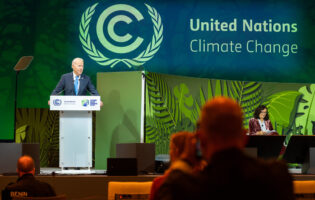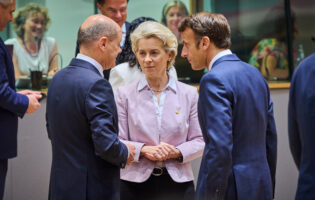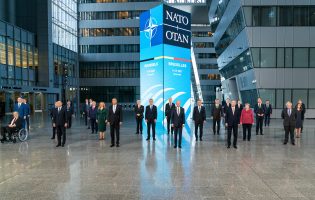
The Eurozone Crisis and Implications for the United States

Peter S. Rashish
Vice President; Director, Geoeconomics Program
Peter S. Rashish, who counts over 25 years of experience counseling corporations, think tanks, foundations, and international organizations on transatlantic trade and economic strategy, is Vice President and Director of the Geoeconomics Program at AICGS. He also writes The Wider Atlantic blog.
Mr. Rashish has served as Vice President for Europe and Eurasia at the U.S. Chamber of Commerce, where he spearheaded the Chamber’s advocacy ahead of the launch of the Transatlantic Trade and Investment Partnership. Previously, Mr. Rashish was a Senior Advisor for Europe at McLarty Associates, and has held positions as Executive Vice President of the European Institute, on the Paris-based staff of the International Energy Agency, and as a consultant to the World Bank, the German Marshall Fund of the United States, the Atlantic Council, the Bertelsmann Foundation, and the United Nations Conference on Trade and Development.
Mr. Rashish has testified on the euro zone and U.S.-European economic relations before the House Financial Services Subcommittee on International Monetary Policy and Trade and the House Foreign Affairs Subcommittee on Europe and Eurasia and has advised three U.S. presidential campaigns. He is a member of the Board of Directors of the Jean Monnet Institute in Paris and a Senior Advisor to the European Policy Centre in Brussels. His commentaries have been published in The New York Times, the Financial Times, The Wall Street Journal, Foreign Policy, and The National Interest, and he has appeared on PBS, CNBC, CNN, and NPR.
He earned a BA from Harvard College and an M.Phil. in international relations from Oxford University. He speaks French, German, Italian, and Spanish.
__
Thank you Chairman Miller, Ranking Member McCarthy, and distinguished members of the House Financial Services Subcommittee on International Monetary Policy and Trade. My name is Peter Rashish, and I am Vice President for Europe and Eurasia at the U.S. Chamber of Commerce.
The transatlantic commercial relationship is by far the largest in the world, with the United States and the European Union surpassing $4.3 trillion in trade, investment and sales by foreign affiliates of companies in one another’s markets. U.S. companies have over $1 trillion invested in the EU. In Ireland alone, the stock of U.S. FDI totaled $165 billion at the end of 2009 — more than the U.S. total for China, India, Russia, and Brazil combined. EU investment in the U.S. supported 3.6 million jobs in 2008. EU investment in California alone supported 287,000 jobs, while its investment in New York supported 255,000 jobs.
These figures make it plain that the fate of the U.S. economy is intimately entwined with the fate of the European Union and the Eurozone. Because of the deep level of integration between our two economies, we will sink or swim together.
The collapse of the Eurozone would not only mean the end of the common currency and the efficiencies it has brought to the European economy but would also likely lead to the disintegration of one of the EU’s crowning achievements — the single market enacted in 1992. Without the single market and its “four freedoms” of movement of people, goods, services, and capital, not only would Europe’s economy suffer but U.S. companies would no longer be able to benefit from operating across a barrier-free EU internal market just as Europeans firms do.
While Europe’s political commitment to finding a solution is strong, it is struggling to identify the right policy tools to contain financial contagion, shore up the banking system, and rein in fiscal deficits while boosting economic growth. Without economic growth, no amount of budgetary austerity or financial rescue programs will provide a long-term solution to Europe’s economic woes.
Where can Europe find the economic growth it needs — and which would ensure that the U.S. continues to reap the enormous commercial benefits from its trade and investment with the European Union?
One avenue is for EU member states to pursue structural reforms of their economies that would liberate growth. Another path is for Europe to invigorate its push to complete its single market. While most barriers to trade across the EU have fallen, an important number remain in the services sector. The creation of the single market has led to a surge in intra-EU investment. This internal dynamism has been a key source of the EU’s economic growth, and the elimination of the remaining barriers in its market would have major benefits for it economy — and for ours.
There is, however, one area that until now has been neglected as a source of increased economic growth in the EU and for that matter in the U.S. — the trade relationship between the two commercial partners. If the two transatlantic economic powers want to inject more dynamism into their economies in a non-inflationary way, there is one quick step they should consider: agree to eliminate all tariffs in transatlantic trade.
While tariffs are low between the U.S. and the EU, because of the enormous size of the economic relationship even small steps can yield significant gains in prosperity. According to a report by the Brussels-based European Center for International Political Economy, a “Transatlantic Zero” tariff-elimination initiative would increase combined U.S.-EU GDP by $180 billion within five years. That is more added growth than either would receive from the completion of the Doha Round of multilateral trade talks.
While the Doha Round is facing serious obstacles to its completion, a “Transatlantic Zero” deal could be agreed quickly as the kinds of issues that have held up bilateral trade pacts in the past — social, labor, and environmental standards — should not be a factor between the U.S. and the EU.
The U.S. and the EU should be ambitious and not stop at eliminating tariffs. They should aim to open up their services markets to each other, create a single investment area, and pursue compatible regulatory regimes. Such an initiative does not have to be a traditional free trade agreement, based on a single undertaking, which could take years to complete if progress in one area is dependent on how far negotiators have gotten in another. But to avoid the unfulfilled solemn declarations of the past, the U.S. and the EU should commit themselves in a legally binding way to the achievement of a barrier-free transatlantic market.
On November 28th, the United States and the European Union will hold a summit meeting in Washington in which President Obama will welcome EU Council President Van Rompuy and European Commission President Barroso. An announcement at the summit of a bold transatlantic initiative for jobs and economic growth including the elimination of tariffs on bilateral trade would inject a sorely needed sense of confidence into both the U.S. and EU economies and once negotiated would produce significant economic benefits to both sides.
A transatlantic trade agreement would not in itself free the EU and the Eurozone of the task of finding lasting solutions to the current crisis. But it would create prospects for growth in Europe without which the crisis will be likely to endure.
The U.S. Chamber of Commerce looks forward to working with the members of the Subcommittee to seek the full benefits of the transatlantic economy for American workers and companies. Thank you very much.
Peter Rashish is the Vice President, Europe &Eurasia at the U.S. Chamber of Commerce and is a frequent contributor to AGI publications and events.
This essay appeared in the October 28, 2011 AGI Advisor.








